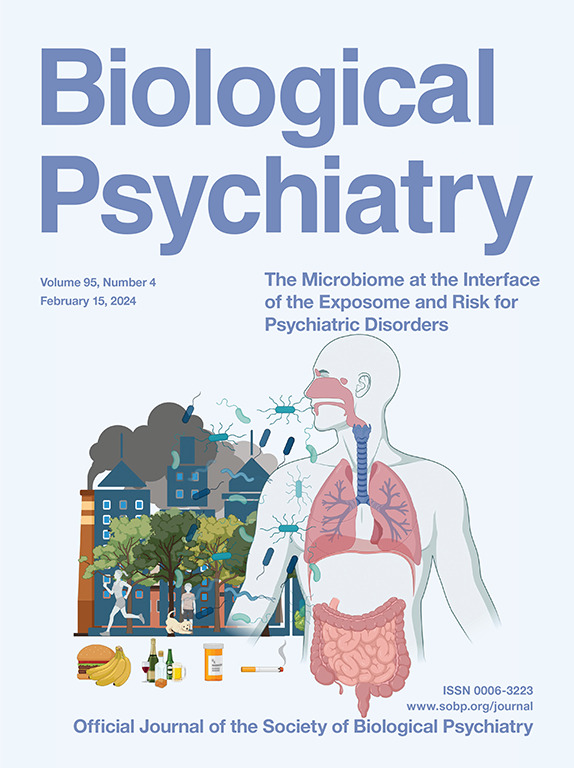Genome-Wide Association Study Meta-Analysis of 9619 Cases With Tic Disorders
IF 9.6
1区 医学
Q1 NEUROSCIENCES
引用次数: 0
Abstract
Background
Despite the significant personal and societal burden of tic disorders (TDs), treatment outcomes remain modest, necessitating a deeper understanding of their etiology. Family history is the biggest known risk factor, and identifying risk genes could accelerate progress in the field.
Methods
Expanding upon previous sample size limitations, we added 4800 new TD cases and 971,560 controls and conducted a genome-wide association study (GWAS) meta-analysis with 9619 cases and 981,048 controls of European ancestry. We attempted to replicate the results in an independent deCODE genetics GWAS (885 TD cases and 310,367 controls). To characterize GWAS findings, we conducted several post-GWAS gene-based and enrichment analyses.
Results
A genome-wide significant hit (rs79244681, p = 2.27 × 10−8) within MCHR2-AS1 was identified, although it was not replicated. Post-GWAS analyses revealed a 13.8% single nucleotide polymorphism heritability and 3 significant genes: BCL11B, NDFIP2, and RBM26. Common variant risk for TD was enriched within genes preferentially expressed in the cortico-striato-thalamo-cortical circuit (including the putamen, caudate, nucleus accumbens, and Brodmann area 9) and 5 brain cell types (excitatory and inhibitory telencephalon neurons, inhibitory diencephalon and mesencephalon neurons, and hindbrain and medium spiny neurons). TD polygenic risk was enriched within loss-of-function intolerant genes (p = .0017) and high-confidence neurodevelopmental disorder genes (p = .0108). Of 112 genetic correlations, 43 were statistically significant, showing high positive correlations with most psychiatric disorders. Of the 2 single nucleotide polymorphisms previously associated with TDs, one (rs2453763) replicated in an independent subsample of our GWAS (p = .00018).
Conclusions
This GWAS was still underpowered to identify high-confidence, replicable loci, but the results suggest imminent discovery of common genetic variants for TDs.
对 9,619 例抽搐症病例的全基因组关联研究荟萃分析。
背景:尽管抽搐症(TD)给个人和社会带来了沉重负担,但治疗效果仍然不佳,因此有必要加深对其病因的了解。家族史是已知的最大风险因素,识别风险基因可加快该领域的研究进展:在以往样本量有限的基础上,我们新增了 4,800 例 TD 病例和 971,560 例对照,并对欧洲血统的 9,619 例病例和 981,048 例对照进行了 GWAS 元分析。我们试图在独立的 deCODE Genetics GWAS(885 例 TD 病例和 310,367 例对照)中复制这些结果。为了描述 GWAS 研究结果的特征,我们进行了多项基于基因的后 GWAS 分析和富集分析:结果:在MCHR2-AS1中发现了一个全基因组范围内的显着基因突变(rs79244681,p=2.27x10-08),但没有得到重复。GWAS后分析显示,SNP遗传率为13.8%,有三个重要基因:BCL11B、NDFIP2 和 RBM26。TD的常见变异风险富集在皮质-纹状体-眼球-皮层回路(包括普门、尾状核、凹凸核和布罗德曼第9区)和五种脑细胞类型(兴奋性和抑制性端脑、抑制性双脑和间脑、后脑和中棘神经元)中优先表达的基因中。TD多基因风险富集在功能缺失不耐受基因(p=0.0017)和高置信度神经发育障碍基因(p=0.0108)中。在 112 个遗传相关基因中,43 个具有统计学意义,显示出与大多数精神疾病的高度正相关性。在先前与 TD 相关的两个 SNPs 中,有一个(rs2453763)在我们的 GWAS 的独立子样本中得到了重复(p=0.00018):这项全球基因组研究在确定高置信度、可复制的基因位点方面仍显不足,但研究结果表明即将发现TD的常见基因变异。
本文章由计算机程序翻译,如有差异,请以英文原文为准。
求助全文
约1分钟内获得全文
求助全文
来源期刊

Biological Psychiatry
医学-精神病学
CiteScore
18.80
自引率
2.80%
发文量
1398
审稿时长
33 days
期刊介绍:
Biological Psychiatry is an official journal of the Society of Biological Psychiatry and was established in 1969. It is the first journal in the Biological Psychiatry family, which also includes Biological Psychiatry: Cognitive Neuroscience and Neuroimaging and Biological Psychiatry: Global Open Science. The Society's main goal is to promote excellence in scientific research and education in the fields related to the nature, causes, mechanisms, and treatments of disorders pertaining to thought, emotion, and behavior. To fulfill this mission, Biological Psychiatry publishes peer-reviewed, rapid-publication articles that present new findings from original basic, translational, and clinical mechanistic research, ultimately advancing our understanding of psychiatric disorders and their treatment. The journal also encourages the submission of reviews and commentaries on current research and topics of interest.
 求助内容:
求助内容: 应助结果提醒方式:
应助结果提醒方式:


